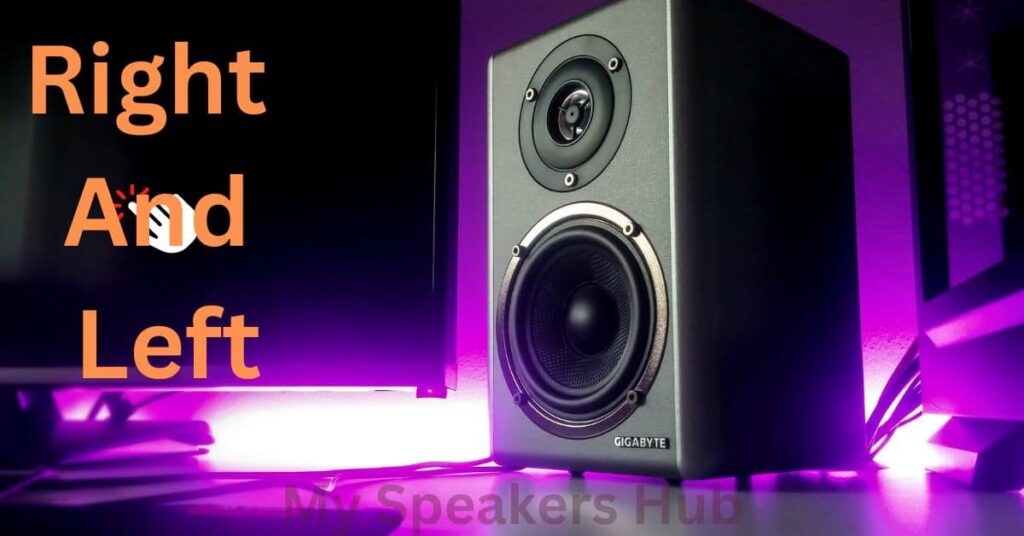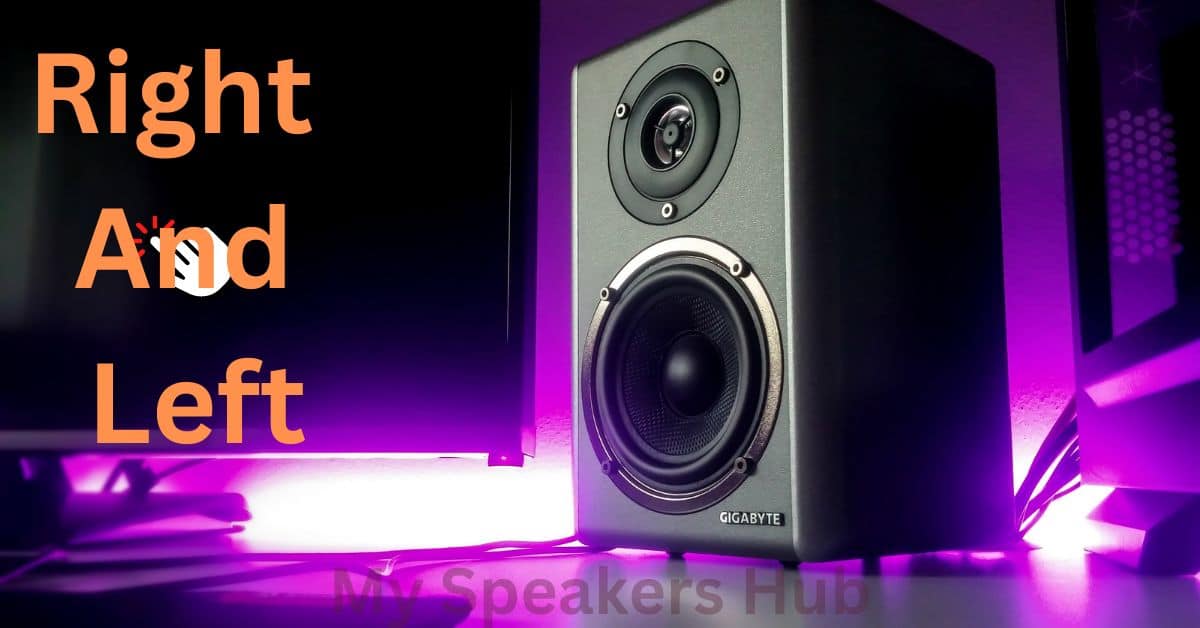There are two main types of speakers: right-handed speakers and left-handed speakers. Right-handed speakers are more common, but left-handed speakers are becoming more popular. Each type of speaker has its own advantages and disadvantages.

How to Tell Which Speaker is Right and left
There are a few ways to determine which speaker is the right channel and which is the left channel. If you have a stereo receiver or amplifier, the right channel will typically be labeled “Right” or “R,” and the left channel will be labeled “Left” or “L.” If you’re using a computer or portable music player, the right channel is usually the one with the higher volume.
Another way to tell which speaker is which is by looking at the waveform of the audio signal. The right channel will have a waveform that is inverted (upside down) from the left channel. This can be seen on a oscilloscope, or by using a free audio editing program like Audacity to look at the waveforms of the audio signal.
Finally, you can also tell which speaker is which by the way the sound is coming out of each speaker. The left channel will typically have the sound coming out from the left side of the speaker, and the right channel will have the sound coming out from the right side of the speaker.
The Difference Between Right and left Speakers
There are several noticeable differences between right and left speakers. The most obvious difference is the direction the speaker is facing. Right speakers are designed to face the right side of the room, while left speakers are designed to face the left side of the room. This difference is necessary to create the stereo effect that is desired.
Another difference between right and left speakers is the wattage. Right speakers typically have more wattage than left speakers. This is because the right speaker is responsible for carrying the majority of the sound. The left speaker simply reinforces the sound that is coming from the right speaker.
Finally, another difference between right and left speakers is the size. Right speakers are typically larger than left speakers. This is because the right speaker needs to produce more sound than the left speaker.
While there are several differences between right and left speakers, the most important difference is the direction the speaker is facing. This is the difference that will create the stereo effect that is desired.
The Benefits of Having Right and left Speakers
There are many benefits to having right and left speakers. One benefit is that it creates a more realistic and immersive soundscape. This is because sounds coming from different directions are naturally processed by our brain in a way that creates a more three-dimensional soundscape. This can be particularly beneficial for music listening, as it can help create a more enveloping and engaging experience.
Another benefit of having right and left speakers is that it can help to improve the clarity of sound. This is because having separate speakers allows for each speaker to be optimally placed for its specific range. This can help to reduce sound distortion and create a more accurate and lifelike sound.

Finally, having right and left speakers can also help to improve the overall dynamic range of sound. This is because each speaker can be independently controlled, which allows for a wider range of volume levels. This can be beneficial for both music listening and movie watching, as it can create a more engaging and exciting experience.
The Importance of Having Right and left Speakers
There are a few reasons why having right and left speakers is important. The most important reason is that it helps create a sense of direction and space. When you have two speakers that are different distances from you, it helps create a sense of depth and space. This is important for creating a realistic and believable soundscape.
Another reason why having right and left speakers is important is because it can help to create a sense of movement. If you have a sound that is moving from one speaker to the other, it can help create a sense of movement and dynamics in the soundscape. This can be particularly effective in action scenes or when there is a lot of movement happening in the scene.
Finally, having right and left speakers can help balance the sound. If you have two speakers that are exactly the same, they can cancel each other out and create a tinny sound. Having two different speakers can help to create a fuller, richer sound.
Overall, having right and left speakers is important for creating a realistic and believable soundscape. It can help to create a sense of direction, space, and movement. It can also help to balance the sound and create a fuller, richer sound.
Frequently Asked Questions [FAQs]
How do I know if my speakers are set up correctly?
To check if your speakers are set up correctly, stand in front of your system and have a friend play a song with strong left/right stereo separation, such as a dance track with a prominent kick drum on the left and a hi-hat on the right. If the kick drum sounds like it’s coming from the right speaker and the hi-hat sounds like it’s coming from the left speaker, then your speakers are set up correctly.
Why is it important to have the right speaker on the right and the left speaker on the left?
It’s important to have the right speaker on the right and the left speaker on the left because this is the way the sound is meant to be heard. When you hear a sound coming from the right, it should come from the right speaker, and when you hear a sound coming from the left, it should come from the left speaker. This creates the illusion of being in the same room as the music, which is the goal of stereo sound.
Can I use a left speaker for the right channel and a right speaker for the left channel?
No, you cannot use a left speaker for the right channel and a right speaker for the left channel. The reason for this is that the left and right channels are meant to be distinct, and using the wrong speaker for a channel will result in the sounds from that channel being muddy and unclear.
I only have one speaker. Can I still use it for stereo sound?
If you only have one speaker, you can still use it for stereo sound by placing it in the center of the room. This will create the illusion of two speakers, and the stereo effect will be much better than if you were to just use the speaker by itself.
I have two speakers, but they’re not the same model. Can I still use them for stereo sound?
Yes, you can still use two different speakers for stereo sound, as long as they’re the same general size. The reason for this is that the larger the speaker, the lower the frequencies it can reproduce. So, if you have two speakers that are the same size, they will be able to produce the same range of frequencies, and the stereo effect will be just as good as if they were the same model.
I have two speakers, but they’re not the same brand. Can I still use them for stereo sound?
Yes, you can still use two different brands of speakers for stereo sound, as long as they’re the same general size. The reason for this is that the larger the speaker, the lower the frequencies it can reproduce. So, if you have two speakers that are the same size, they will be able to produce the same range of frequencies, and the stereo effect will be just as good as if they were the same brand.
I have two speakers, but one is plugged into the left channel and the other is plugged into the right channel. Can I still use them for stereo sound?
Yes, you can still use two speakers for stereo sound even if one is plugged into the left channel and the other is plugged into the right channel. The reason for this is that the left and right channels are meant to be distinct, and using the wrong speaker for a channel will result in the sounds from that channel being muddy and unclear.
Conclusion
The answer to this question is not as simple as it may seem. While there are some general rules that can help to determine which speaker is right and left, there are also a number of exceptions to these rules. As such, it is generally best to consult with a professional audio engineer or other expert before making any final decisions about which speaker is right and left.


